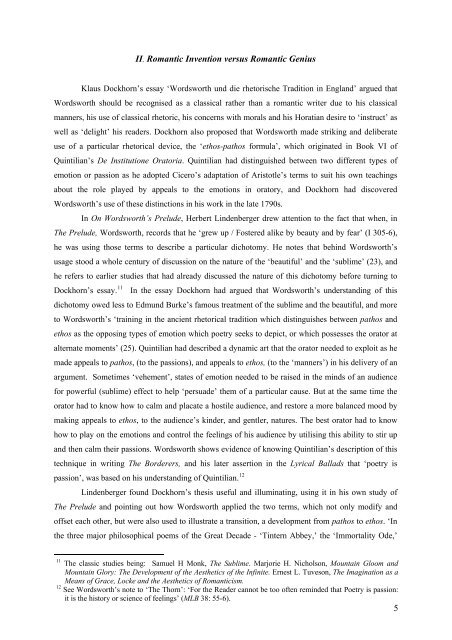Contents - ResearchSpace@Auckland - The University of Auckland
Contents - ResearchSpace@Auckland - The University of Auckland
Contents - ResearchSpace@Auckland - The University of Auckland
Create successful ePaper yourself
Turn your PDF publications into a flip-book with our unique Google optimized e-Paper software.
II. Romantic Invention versus Romantic GeniusKlaus Dockhorn’s essay ‘Wordsworth und die rhetorische Tradition in England’ argued thatWordsworth should be recognised as a classical rather than a romantic writer due to his classicalmanners, his use <strong>of</strong> classical rhetoric, his concerns with morals and his Horatian desire to ‘instruct’ aswell as ‘delight’ his readers. Dockhorn also proposed that Wordsworth made striking and deliberateuse <strong>of</strong> a particular rhetorical device, the ‘ethos-pathos formula’, which originated in Book VI <strong>of</strong>Quintilian’s De Institutione Oratoria. Quintilian had distinguished between two different types <strong>of</strong>emotion or passion as he adopted Cicero’s adaptation <strong>of</strong> Aristotle’s terms to suit his own teachingsabout the role played by appeals to the emotions in oratory, and Dockhorn had discoveredWordsworth’s use <strong>of</strong> these distinctions in his work in the late 1790s.In On Wordsworth’s Prelude, Herbert Lindenberger drew attention to the fact that when, in<strong>The</strong> Prelude, Wordsworth, records that he ‘grew up / Fostered alike by beauty and by fear’ (I 305-6),he was using those terms to describe a particular dichotomy. He notes that behind Wordsworth’susage stood a whole century <strong>of</strong> discussion on the nature <strong>of</strong> the ‘beautiful’ and the ‘sublime’ (23), andhe refers to earlier studies that had already discussed the nature <strong>of</strong> this dichotomy before turning toDockhorn’s essay. 11 In the essay Dockhorn had argued that Wordsworth’s understanding <strong>of</strong> thisdichotomy owed less to Edmund Burke’s famous treatment <strong>of</strong> the sublime and the beautiful, and moreto Wordsworth’s ‘training in the ancient rhetorical tradition which distinguishes between pathos andethos as the opposing types <strong>of</strong> emotion which poetry seeks to depict, or which possesses the orator atalternate moments’ (25). Quintilian had described a dynamic art that the orator needed to exploit as hemade appeals to pathos, (to the passions), and appeals to ethos, (to the ‘manners’) in his delivery <strong>of</strong> anargument. Sometimes ‘vehement’, states <strong>of</strong> emotion needed to be raised in the minds <strong>of</strong> an audiencefor powerful (sublime) effect to help ‘persuade’ them <strong>of</strong> a particular cause. But at the same time theorator had to know how to calm and placate a hostile audience, and restore a more balanced mood bymaking appeals to ethos, to the audience’s kinder, and gentler, natures. <strong>The</strong> best orator had to knowhow to play on the emotions and control the feelings <strong>of</strong> his audience by utilising this ability to stir upand then calm their passions. Wordsworth shows evidence <strong>of</strong> knowing Quintilian’s description <strong>of</strong> thistechnique in writing <strong>The</strong> Borderers, and his later assertion in the Lyrical Ballads that ‘poetry ispassion’, was based on his understanding <strong>of</strong> Quintilian. 12Lindenberger found Dockhorn’s thesis useful and illuminating, using it in his own study <strong>of</strong><strong>The</strong> Prelude and pointing out how Wordsworth applied the two terms, which not only modify and<strong>of</strong>fset each other, but were also used to illustrate a transition, a development from pathos to ethos. ‘Inthe three major philosophical poems <strong>of</strong> the Great Decade - ‘Tintern Abbey,’ the ‘Immortality Ode,’11 <strong>The</strong> classic studies being: Samuel H Monk, <strong>The</strong> Sublime. Marjorie H. Nicholson, Mountain Gloom andMountain Glory: <strong>The</strong> Development <strong>of</strong> the Aesthetics <strong>of</strong> the Infinite. Ernest L. Tuveson, <strong>The</strong> Imagination as aMeans <strong>of</strong> Grace, Locke and the Aesthetics <strong>of</strong> Romanticism.12 See Wordsworth’s note to ‘<strong>The</strong> Thorn’: ‘For the Reader cannot be too <strong>of</strong>ten reminded that Poetry is passion:it is the history or science <strong>of</strong> feelings’ (MLB 38: 55-6).5














